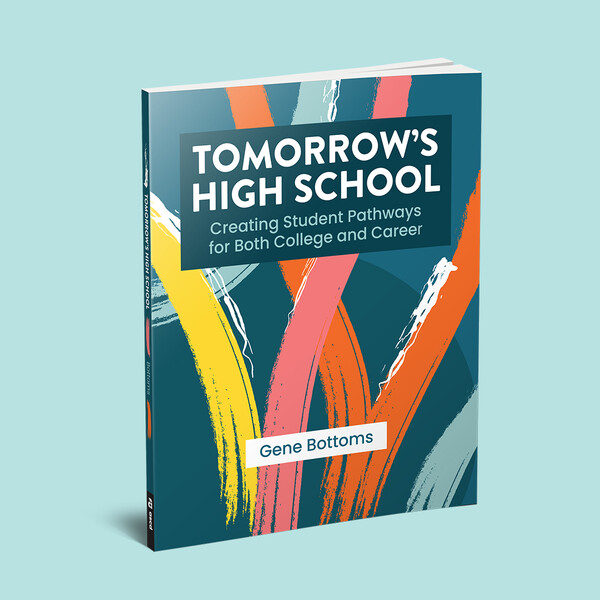Schools are not doing enough to prepare high school students for postsecondary education, careers, or both. Twenty of 26 states that released their data publicly saw drops in their high school graduation rates last year, according to the education news organization Chalkbeat. The trend suggests the pandemic has created new barriers to success.
In his recently published book Tomorrow’s High School: Creating Student Pathways for Both College and Career (ASCD, 2022), Gene Bottoms, former director of the High Schools That Work initiative, emphasizes the importance of the transition to high school in preparing students for more rigorous coursework and career pathways. In this adapted excerpt, he provides two key steps to strengthen and smooth that transition—and, ultimately, students’ path to graduation. “Without a joint effort by middle and high schools to ensure students arrive at high school prepared to succeed,” he writes, “many schools will never achieve the goals of graduating 95 percent of students entering the 9th grade [to 10th grade] and having 90 percent graduate from high school truly ready for postsecondary education, careers, or both.”
How can schools adopt approaches to make sure students are ready for rigorous high school courses, ultimately preparing them for any path they choose after high school? Two important steps in the process are forming a transition action team and developing a statement of need.
Form a Transition Action Team
District, school, teacher, and counselor leaders can form a middle to high transition (MHT) action team for the school district or for one high school and its feeder middle schools. The MHT action team’s objective is to develop a plan that
- Provides accelerated literacy and mathematics instruction in grades 6, 7, 8, and 9, with extended time and support for students who need it.
- Identifies rising 9th graders who could succeed in challenging college-ready courses in 9th grade if they were assigned to the right teachers and received intensive, unconditional support.
- Identifies rising 9th graders who have major achievement deficits and will need extra time and extensive support to succeed in college preparatory English language arts, social studies, algebra, and science courses and a rigorous career pathway course.
Central to this plan will be a redesigned schedule to provide extended time and assistance to those needing extra support—and ensuring that students develop the habits of independent and responsible learners—so that at least 95 percent of students earn enough credits during their 9th grade year to successfully transition to 10th grade.
The MHT action team needs to establish a close partnership between 9th grade and middle school educators to reduce the percentages of students entering high school unprepared for challenging studies.
Members of the MHT action team should include the high school principal or assistant principal, a counselor, and lead English language arts, mathematics, science, and career pathway teachers. From the primary feeder middle school, the team should include a principal, a counselor, and English language arts, mathematics, science, and career exploratory teachers. The team may also include a concerned parent, a key leader from the district office, or an outside facilitator with expertise in middle to high school transition. Educators who have been successful teachers at both the middle and high school levels can bring important perspectives to the team.
Prepare a Statement of Need
To increase the percentages of students across all socioeconomic status (SES) and racial/ethnic groups who are on pace to graduate from high school and graduate college-ready, career-ready, or both, the MHT action team will need to determine a baseline and prepare a statement of need. In addition to data gathered by the “data, accountability, and policy action team” (as described in Chapter 3), this information should include the percentages of students who
- Are ready at the end of the 7th and 8th grades for challenging college preparatory courses.
- Need extended time and support to succeed in a college prep course of study in 9th grade.
- Need a proven teacher, intensive support, and extended time to complete college prep English language arts and Algebra I by the end of 9th grade.
Making these determinations involves studying 7th and 8th grade assessment data, as well as indicators such as student grades, attendance, and discipline issues. The MHT action team should also monitor annual increases in the percentages of students enrolled in and completing four truly college preparatory courses in 10th grade.
The MHT action team should also compile information around the following questions:
- Which sequence of courses in 9th grade represents the true college preparatory curriculum? What are the indicators currently used to place students in the college prep courses (e.g., performance on state exams, performance in key 7th and 8th grade courses, teacher recommendations)?
- Based on your high school’s current indicators for enrolling students into college prep courses, how closely do the students chosen for these courses reflect the socioeconomic and racial demographics of the entire incoming 9th grade class? How might you modify your indicators to select an additional 25 percent (or more) to be mainstreamed into college prep courses in 9th grade? Would such an approach increase the percentage of low-SES or minority students who pursue this level of study?
- Challenge yourself to look at this possibility differently and face your own potential biases: How do the learning experiences of students in grades 6 through 8 who fail to meet readiness indicators for college prep courses in grade 9 differ from students who meet your indicators with regard to types of assignments given, courses taken, and the experience and strengths of their teachers?
After analyzing these and other data, the MHT action team must determine the root causes underlying gaps in students’ readiness for a true college preparatory high school curriculum. The team must investigate and determine its blind spots by analyzing data and information collected around key questions such as, How are the assignments and classroom assessments given to prepared students different from assignments and assessments given to unprepared students in grades 6 through 9? [See book for additional questions.]
The transition team also should determine the causes for the blind spots in school and classroom practices in grades 6 to 9 that perpetuate a continuing supply of students who did not have access to a challenging and meaningful curriculum that prepares them for college and careers.
The resulting analyses by the MHT action team can help schools recognize that the best instruction and assignments given to the best students must be given to all students—with extended time and support needed by some to achieve at a higher level. Otherwise, there is little hope that schools will significantly increase the percent of historically underserved students who can meet the bold goals and become successful in postsecondary studies and careers.
Tomorrow's High School
Drawing from his experience with the High Schools That Work initiative, Gene Bottoms outlines bold actions schools can take to achieve bold goals.









